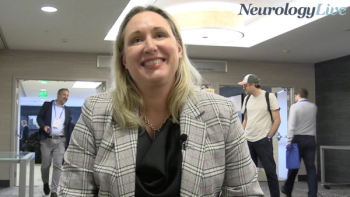
Ubrogepant Effective for Migraine Patients With Insufficient Triptan Response
The recently approved Allergan agent reported lower rates of functional disability and better overall satisfaction with treatment, as well as similar success for those who did not experience efficacy with triptans.
Richard B. Lipton, MD
Those with migraine who experience an insufficient response to triptans who are treated with ubrogepant (Ubrelvy; Allergan) reported lower rates of functional disability and better overall satisfaction with treatment compared to those randomized to placebo.1
All told, 2 hours post-dose, those treated with ubrogepant reported higher odds of being able to function normally (odds ratio [OR], 1.57; 95% CI, 1.01—2.45; P = .046) and to be satisfied or extremely satisfied with the trial medication (OR, 1.84; 95% CI, 1.19—2.83; P = .006). Additionally, a higher proportion of ubrogepant-treated patients indicated that migraine was much better or very much better 2 hours post initial dose, as measured by the Patient Global Impression of Change (PGIC; OR, 2.00; 95% CI, 1.22—3.29; P = .006), and there were no differences in treatment effects based on historical triptan experiences.
The data, pulled from the ACHIEVE I (NCT02828020) and II (NCT02867709) trials, were presented by Richard B. Lipton, MD, director, Montefiore Headache Center and professor of neurology, Albert Einstein College of Medicine, at the
“We’ve seen that a significantly higher proportion of triptan-insufficient responders treated with ubrogepant reported being able to function normally from 2 to 8 hours after the initial dose, in comparison with placebo-treated patients,” Lipton said in his presentation. “We’ve seen that more triptan-insufficient responders who took ubrogepant were satisfied with the treatment at 2 and 24 hours and indicated improvement in their migraine at 2 hours versus placebo.”
READ MORE:
At baseline, 38% of participants (n = 682) were categorized as triptan responders, 25% (n = 451) as triptan insufficient responders, and 37% (n = 666) as triptan naïve. Those who were deemed insufficient responders made up 24.5% (n = 223) of placebo group and 25.7% (n = 228) of the ubrogepant group. The subgroups of insufficient responders in each group included those with insufficient efficacy (placebo: 78% [n = 174]; ubrogepant: 81.1% [n = 185]), poor tolerability (placebo: 17% [n = 38]; ubrogepant: 16.2% [n = 37]), and contraindications (placebo: 3.1% [n = 7]; ubrogepant: 2.2% [n = 5]).
Lipton noted that the oral calcitonin gene-related peptide (CGRP) antagonist was deemed both safe and well-tolerated with no new safety signals.
“In terms of safety, the incidence of treatment-emergent adverse events [AEs] and treatment-related AEs did not differ appreciably across historical triptan use subgroups. Among triptan-insufficient responders, 12.1% of participants in the placebo group and 15.4% of participants in the ubrogepant group reported treatment-emergent AEs within 48 hours. No serious AEs were reported in any subgroup,” he explained.
Patients in the 2 groups were compared based on Functional Disability Scale (FDS) scores at 2, 4, and 8 hours post-dose. At those respective time points, the proportion of insufficient triptan responders in the ubrogepant group who were able to function normally was 38%, 56%, and 73%. In comparison, for those same time points, 29%, 40%, and 57% of the placebo group reported normal function (P <.05 for all).
For the subgroup of patients with insufficient efficacy with triptans, the results were similar, though only significant at the 4- and 8-hour time points. All told, 56% and 72% of the ubrogepant group reported normal function at 4 and 8 hours, respectively, compared to 39% and 55% of the placebo group (P <.05 for both). At 2 hours, 36% of the ubrogepant group reported normal function compared to 26% of the placebo group.
As for treatment satisfaction, 33% (n = 224) and 58% (n = 206) of the full ubrogepant-treated group reported being satisfied at 2 and 24 hours, respectively, compared to 21% (n = 215) and 28% (n = 204) of the placebo group (P <.05 for both). For the insufficient efficacy subgroup, the ubrogepant-treated patients were satisfied with treatment at rates of 32% (n = 181) and 57% (n = 165), respectively, compared to 17% (n = 167) and 25% (n = 160) of the placebo group (P <.05 for both).
Ubrogepant was approved for the acute treatment of migraine with or without aura by the FDA in December 2019, making it the first-in-class oral CGRP antagonist for this indication.2
Earlier this year, at the now-canceled
Watch Ailani share her insight on those findings on ubrogepant from AAN below.
For more coverage of AHS 2020,
REFERENCE
1. Lipton RB, Singh RH, Revicki D, et al. Improved Functionality, Satisfaction, and Global Impression of Change with Ubrogepant for the Acute Treatment of Migraine in Triptan Insufficient Responders. Headache. 2020;60(S1 suppl). 1-156. doi: 10.1111/head.13854
2. FDA approves new treatment for adults with migraine. News release. FDA. December 23, 2019. Accessed June 15, 2020. fda.gov/news-events/press-announcements/fda-approves-new-treatment-adults-migraine
3. Ailani J, Blumenfeld A, Klein B, et al. An Optional Second Dose of Ubrogepant is Effective in Achieving 2-Hour Pain Freedom in the Acute Treatment of Migraine. Neurology. 2020;94(15 Suppl): 166.
Newsletter
Keep your finger on the pulse of neurology—subscribe to NeurologyLive for expert interviews, new data, and breakthrough treatment updates.




































